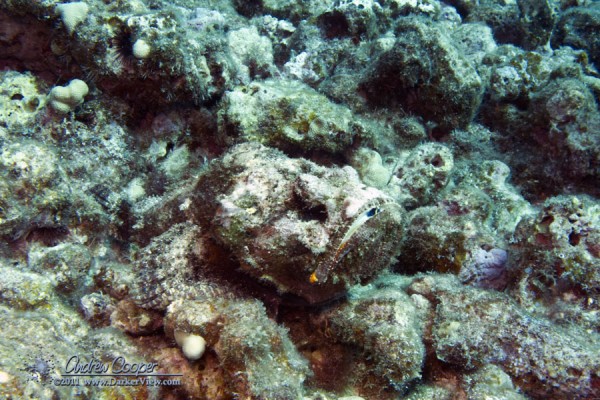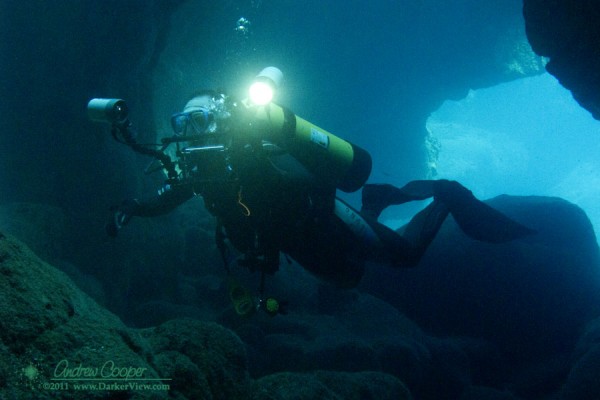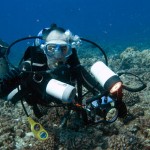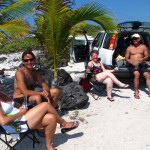That rock just moved, I am sure of it! Did it? Olivier was gesturing emphatically at a pile of coral rubble. I looked… I looked again, there must be something there. There was…

When you want to see the stars, find someplace dark
Exploring the wet
There are some devices that folks still try to repair if possible, camera gear seems to be at the top of the list. I suppose this should not be a surprise, the gear is expensive, and seems to get damaged from hard use. Particularly on this island, where cameras see a wide range of harsh conditions, from tropical heat to salt water.
A month back I repaired a Pentax waterproof camera for a co-worker. Salt water had penetrated around the shutter button and corroded the switch. The camera, rated to 10m (30ft), had probably experienced pressures even higher. Her teenage boys can easily exceed that depth while free diving the island reefs. It was necessary to completely disassemble the camera to get at the button. Well over an hour of tiny screws and gaskets to replace a $1.35 switch.
There have been other items this year… A classic chrome stand microphone that required a little rewiring to work with a modern computer. A pair of very nice computer monitors now found on my desk. A toy RC aircraft with broken motor leads. I do appear to have gained a reputation for fixing this stuff.
Last week it was an underwater video camera case brought to me. None of the external controls were working, no way to hit record once in the water. The repair turned out to be fairly simple, a broken conductor in the LANC cable used to control the camera. A bit of scrounging around in my spare parts to build a replacement cable was all that was required to put everything right. Most repairs are that sort of simple, just the effects of wear and tear taking their toll.
After the repair J sent me a link to his YouTube channel and I spent a lunch watching video. Well edited, nicely crafted videos of the local paddling sport community. Canoe races and special events covered with a personal touch, with respect for the people and traditions. I was very happy to see I had done a bit to help someone who was producing such excellent material.
The repairs serve me as well. Each time I take apart an unfamiliar device I learn, I refresh my skills, I experience the simple joy of using those skills. Each device is a challenge, to successfully disassemble the gear, find the fault, and put it all back together properly. On occasion I fail in that challenge, either I do not have the skill, or the repair is impractical, or the device too badly damaged. There is often little real risk, if it is broken the attempt to save something useful from the trash is an easy choice, the only thing lost is the effort. The reward is seeing the gear returned to useful service and knowing you prevented that little bit of waste.
I wonder what will come my way next time?
An example of J’s Videosthe Kona Coast is riddled with caves, old lava tubes, wave carved openings in ancient sea cliffs, or simple small openings in the coral. The caves are high on many diver’s priority lists when exploring the reef. In these caves you find many species that hide during the light of day, lobsters and night active fish. The larger caves offer a sheltered environment, safe from the pounding winter surf. The walls are covered with colorful sponges and the nudibranchs that feed on them.
If there is a cave, you will probably note my fins disappearing into it.

These sea cucumbers are well known to divers and can be found in the local guide books. There is no scientific name, the species has never been properly described. An odd state of affairs for a relatively common critter. As for the name? I could come up with a few other common names that seem to describe the appearance. However, naming a species after a pile of doo-doo is not generally acceptable.

Black Friday, a phrase that brings to mind stores jammed with shoppers seeking the first Christmas sales. Not my idea of fun and something to be completely avoided if at all possible. Better to spend the day where credit cards do not work… Possibly under water?
The plan was to return to O’oma and the dive sites near the popular Pine Trees surfing breaks. The area is very good diving, with many sites and entries to choose from along a half mile of coastline, From OTEC to Kaloko. The area is popular with the dive boats as well, we were dropping into the water mere yards from the moorings used by the Honokohau diving operations. As we prepared for the dive we watched as the boats did as well, we just did it without paying $150 per person. The only disadvantage? We had to walk across 50 yards of pahoehoe lava to get to the lava, not a problem with the very gentle swell of the day. Entry was quite easy with a sheltered shallows available just in from the popular Suck ’em Up cave and dive site.

It really was one of those perfect days to live in Hawaii.
First stop on the way was to get some air. Our tanks were empty, something we needed to change. This was accomplished at The Scuba Shack, a great dive shop just below Costco on the Kaloko business park. It is a funky place, with anything and everything a diver needs. One of the best services offered is quick fills… In and out in about five minutes with two full tanks of air, $5 each.

Supposedly common, I have been poking about in caves for over four years without seeing these attractive lobsters. In this cave were several of them. I caught this guy in a corner, he wanted to get past me, but could not get past the light. Good thing for him it isn’t lobster season.

With my face behind the camera, and looking the other direction, I did not notice the commotion I had caused. A swirl of colorful motion caught the corner of my eye. I turned to see a horde of butterflyfish attacking a seemingly uninteresting rock face. I watched for a moment before a memory triggered… Of course!

It is likely the gang of butterflyfish used my presence as an opening to overwhelm the Sergent. Local lore is full of examples of this behavior. The passage of a larger predatory fish, or a diver, will give the guarding male Sergeant a pause. A slim opening upon which the gang will swarm the eggs and feed. During Sergent breeding season it is not unusual for divers to mention schools of butterflyfish or tangs following them in and around the nesting areas.

I literally have to push my way through the swirling fish to examine the nest. The rock is covered with eggs, an amazing number of little purple dots covering an area of about a meter square. Despite the ongoing feeding frenzy, the nest seems intact, with nearly every bit of the rock covered with the neat little lines of eggs.
Hoover1 makes an interesting observation… “One can only wonder why Sergent eggs are so conspicuous while most damselfish eggs are hardly visible”
1) Hawaiian Reef Fishes, John P. Hoover, Mutual Publishing, 2008